Calcium intake and bone mineral density: systematic review and meta-analysis
- PMID: 26420598
- PMCID: PMC4784773
- DOI: 10.1136/bmj.h4183
Calcium intake and bone mineral density: systematic review and meta-analysis
Abstract
Objective: To determine whether increasing calcium intake from dietary sources affects bone mineral density (BMD) and, if so, whether the effects are similar to those of calcium supplements.
Design: Random effects meta-analysis of randomised controlled trials.
Data sources: Ovid Medline, Embase, Pubmed, and references from relevant systematic reviews. Initial searches were undertaken in July 2013 and updated in September 2014.
Eligibility criteria for selecting studies: Randomised controlled trials of dietary sources of calcium or calcium supplements (with or without vitamin D) in participants aged over 50 with BMD at the lumbar spine, total hip, femoral neck, total body, or forearm as an outcome.
Results: We identified 59 eligible randomised controlled trials: 15 studied dietary sources of calcium (n=1533) and 51 studied calcium supplements (n=12,257). Increasing calcium intake from dietary sources increased BMD by 0.6-1.0% at the total hip and total body at one year and by 0.7-1.8% at these sites and the lumbar spine and femoral neck at two years. There was no effect on BMD in the forearm. Calcium supplements increased BMD by 0.7-1.8% at all five skeletal sites at one, two, and over two and a half years, but the size of the increase in BMD at later time points was similar to the increase at one year. Increases in BMD were similar in trials of dietary sources of calcium and calcium supplements (except at the forearm), in trials of calcium monotherapy versus co-administered calcium and vitamin D, in trials with calcium doses of ≥ 1000 versus <1000 mg/day and ≤ 500 versus >500 mg/day, and in trials where the baseline dietary calcium intake was <800 versus ≥ 800 mg/day.
Conclusions: Increasing calcium intake from dietary sources or by taking calcium supplements produces small non-progressive increases in BMD, which are unlikely to lead to a clinically significant reduction in risk of fracture.
© Tai et al 2015.
Conflict of interest statement
Competing interests: All authors have completed the ICMJE uniform disclosure form at
Figures
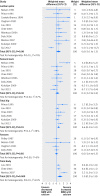
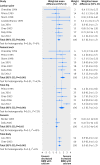
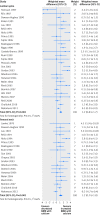
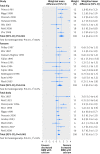
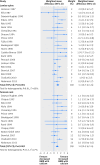


Comment in
-
Calcium supplements do not prevent fractures.BMJ. 2015 Sep 29;351:h4825. doi: 10.1136/bmj.h4825. BMJ. 2015. PMID: 26420735 No abstract available.
-
[Extra calcium in the diet or as a tablet increases bone density only marginally].Praxis (Bern 1994). 2015 Dec 9;104(25):1409. doi: 10.1024/1661-8157/a002220. Praxis (Bern 1994). 2015. PMID: 26649961 German. No abstract available.
-
ACP Journal Club. Review: Dietary or supplemental calcium increase BMD by ≤ 1.8% in persons > 50 years of age.Ann Intern Med. 2016 Jan 19;164(2):JC5. doi: 10.7326/ACPJC-2016-164-2-005. Ann Intern Med. 2016. PMID: 26784495 No abstract available.
References
-
- Consensus conference: Osteoporosis. JAMA 1984;252:799-802. - PubMed
-
- IOM (Institute of Medicine). Dietary reference intakes for calcium and vitamin D. National Academies Press, 2011. - PubMed
-
- Tang BMP, Eslick GD, Nowson C, Smith C, Bensoussan A. Use of calcium or calcium in combination with vitamin D supplementation to prevent fractures and bone loss in people aged 50 years and older: a meta-analysis. Lancet 2007;370:657-66. - PubMed
Publication types
MeSH terms
Substances
LinkOut - more resources
Full Text Sources
Other Literature Sources
Medical
